Harnessing thermal mass can naturally stabilize your home's temperature, reducing energy costs and enhancing comfort. You'll want to incorporate dense materials like concrete, stone, or water in areas that receive direct sunlight. These materials absorb heat during the day and release it at night, helping maintain consistent indoor temperatures. Strategic placement is key—focus on south-facing walls, floors, and even water features for maximum effect. By combining thermal mass with proper insulation and ventilation, you'll create a more energy-efficient home that's cooler in summer and warmer in winter. Exploring this approach can lead to significant long-term benefits for your living space and wallet.
Understanding Thermal Mass
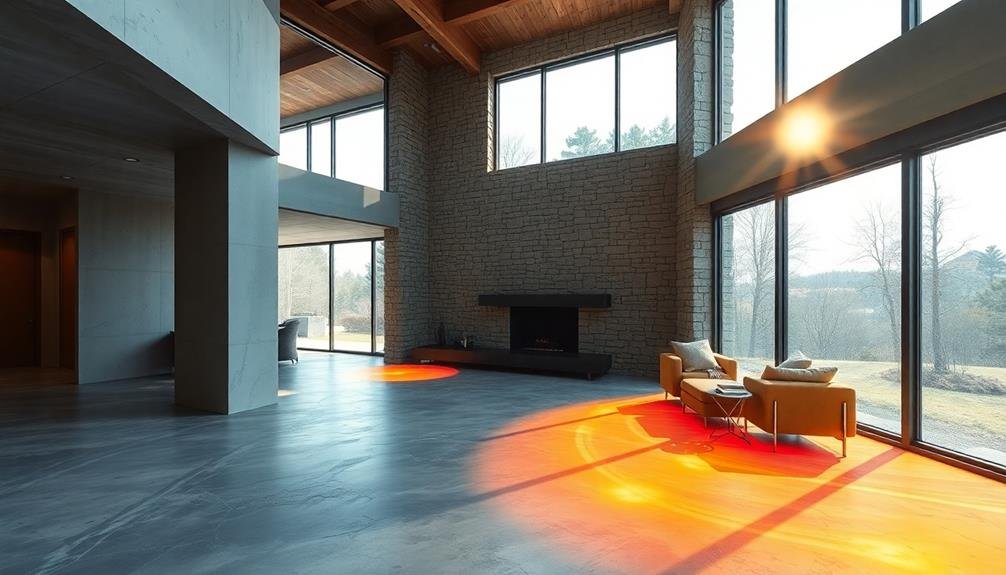
Almost every material has thermal mass, which is its ability to absorb, store, and release heat. When you're considering thermal mass for your home, you'll want to focus on materials with high heat capacity and moderate conductivity. These include concrete, brick, stone, and water.
Thermal mass works by absorbing heat during warm periods and releasing it when temperatures drop. This process helps stabilize indoor temperatures, reducing the need for artificial heating and cooling. In a well-designed home, thermal mass can greatly lower energy costs and improve comfort.
The effectiveness of thermal mass depends on several factors:
- Material type and thickness
- Surface area exposed to heat sources
- Location within the building
- Climate and local weather patterns
You'll get the most benefit from thermal mass in climates with considerable temperature swings between day and night. It's particularly useful in hot, dry areas where it can absorb heat during the day and release it at night, keeping your home cooler.
To maximize thermal mass, consider incorporating dense materials into your home's design, especially in areas that receive direct sunlight or radiant heat.
Benefits of Temperature Stabilization
While thermal mass plays an essential role in temperature stabilization, its benefits extend far beyond mere comfort. You'll notice a significant reduction in energy costs as your heating and cooling systems work less to maintain a consistent indoor climate. This natural temperature regulation also means fewer temperature fluctuations, creating a more pleasant living environment throughout the day.
By harnessing thermal mass, you're not just improving your home's energy efficiency; you're also contributing to a greener planet. The reduced reliance on artificial heating and cooling systems leads to lower carbon emissions and a smaller environmental footprint.
Here's a quick overview of the benefits you can expect:
| Benefit | Short-term Impact | Long-term Impact |
|---|---|---|
| Energy Savings | Lower monthly bills | Reduced overall energy consumption |
| Comfort | Consistent indoor temperature | Improved quality of life |
| Environmental | Reduced carbon emissions | Sustainable living practices |
Additionally, temperature stabilization can help protect your home's structure and contents. By minimizing extreme temperature swings, you'll reduce the risk of material expansion and contraction, which can lead to cracks, warping, and other forms of damage over time.
Common Thermal Mass Materials
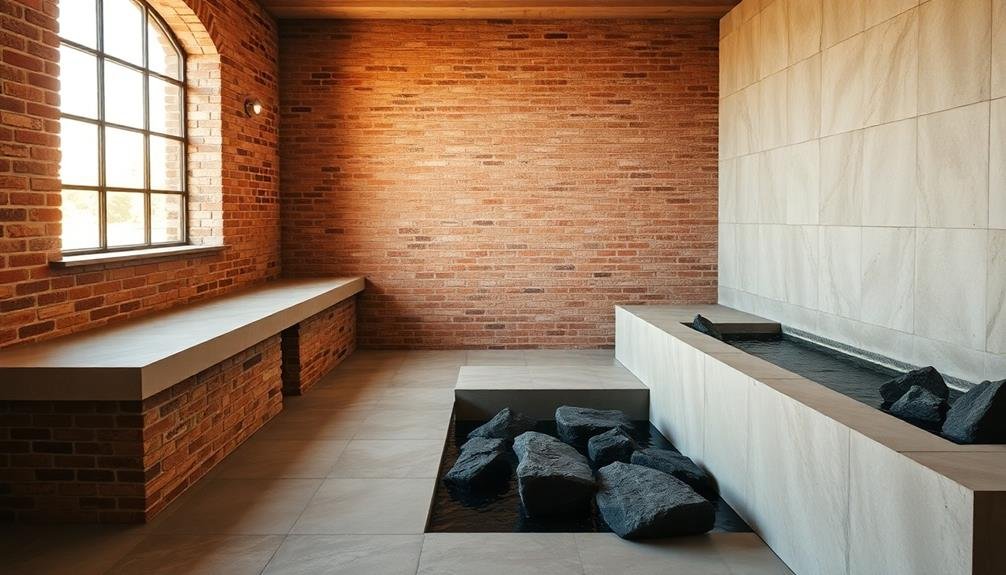
When considering thermal mass materials, you'll find several effective options.
Stone and concrete are popular choices due to their high density and heat retention properties, while water-based thermal storage systems offer excellent capacity for absorbing and releasing heat.
If you're looking for a more natural aesthetic, dense wood options like oak or maple can provide moderate thermal mass capabilities.
Stone and Concrete
Stone and concrete stand as the titans of thermal mass materials. Their high density and specific heat capacity make them excellent choices for regulating indoor temperatures. You'll find these materials commonly used in flooring, walls, and even as decorative elements in homes designed for energy efficiency.
When you're considering stone or concrete for thermal mass, keep these properties in mind:
| Property | Stone | Concrete |
|---|---|---|
| Density | High | High |
| Heat Capacity | High | High |
| Cost | Higher | Lower |
| Aesthetic Options | Varied | Limited |
| Installation | Complex | Versatile |
Both materials absorb heat slowly during the day and release it gradually at night, helping to maintain a stable indoor temperature. You'll benefit most from stone and concrete thermal mass in climates with significant temperature swings between day and night.
To maximize their effectiveness, guarantee these materials are exposed to direct sunlight or radiant heat during the day. You can also enhance their performance by incorporating them into your home's design strategically, such as using concrete floors in south-facing rooms or stone accent walls in areas that receive ample sunlight.
Water-Based Thermal Storage
Another powerhouse in the thermal mass arena is water-based storage. Water has an exceptional ability to absorb and release heat, making it an ideal thermal mass material. You can incorporate water-based thermal storage into your home through various methods.
One popular option is installing a water wall, which consists of large containers filled with water placed strategically in your living space. These walls absorb excess heat during the day and release it at night, helping to maintain a consistent indoor temperature.
Another approach is using water-filled tubes in your flooring system, which can be heated or cooled to regulate room temperature.
You might also consider a rooftop water storage system, where a layer of water on your roof acts as insulation and thermal mass. This setup can notably reduce your cooling needs in hot climates.
For a smaller-scale solution, you can place water-filled containers near windows to capture and store solar heat.
Don't forget about the thermal mass potential of your home's plumbing system. The water in your pipes can contribute to temperature stability, especially if you have a large storage tank.
Dense Wood Options
Moving from liquid to solid, let's explore the thermal mass potential of dense wood options. Dense woods like oak, maple, and walnut can effectively absorb and store heat, helping to stabilize your home's temperature. These hardwoods have a higher thermal mass compared to softwoods, making them ideal for interior applications where you want to regulate temperature fluctuations.
You'll find dense wood options particularly useful in:
- Flooring: Solid hardwood floors can absorb heat during the day and release it at night, helping to maintain a comfortable temperature.
- Furniture: Heavy wooden tables, dressers, or built-in cabinetry can contribute to your home's overall thermal mass.
- Structural elements: Exposed wooden beams or thick wooden walls can add significant thermal mass to your living spaces.
When incorporating dense wood into your home, consider its placement relative to sunlight and heat sources. South-facing rooms with ample sunlight exposure are ideal locations for maximizing the thermal mass benefits of dense wood.
You can also combine dense wood elements with other thermal mass materials for enhanced temperature regulation. Remember that while dense wood isn't as effective as stone or concrete, it offers a more natural and aesthetically pleasing option for increasing your home's thermal mass.
Strategic Placement in Your Home
When it comes to maximizing the benefits of thermal mass in your home, strategic placement is essential. Focus on areas that receive direct sunlight during the day, such as south-facing walls and floors. These surfaces will absorb heat and slowly release it as temperatures drop, helping to stabilize your home's interior climate.
In living spaces, consider incorporating thermal mass materials into flooring or feature walls. Concrete or tile floors work well in sunrooms or areas with large windows. For bedrooms, place thermal mass on the north side to buffer against temperature fluctuations.
Don't overlook your kitchen and bathroom. These high-humidity areas can benefit from thermal mass to help regulate moisture levels. Install stone countertops or tile backsplashes to capture and store heat.
For outdoor spaces, use thermal mass in patios or garden walls to create comfortable microclimates. This can extend your outdoor living season by providing warmth in cooler months.
Remember to balance thermal mass with proper insulation and ventilation. Too much thermal mass can lead to overheating, so consider your local climate and consult with a professional to determine the best amount and placement for your specific home.
Incorporating Water Features
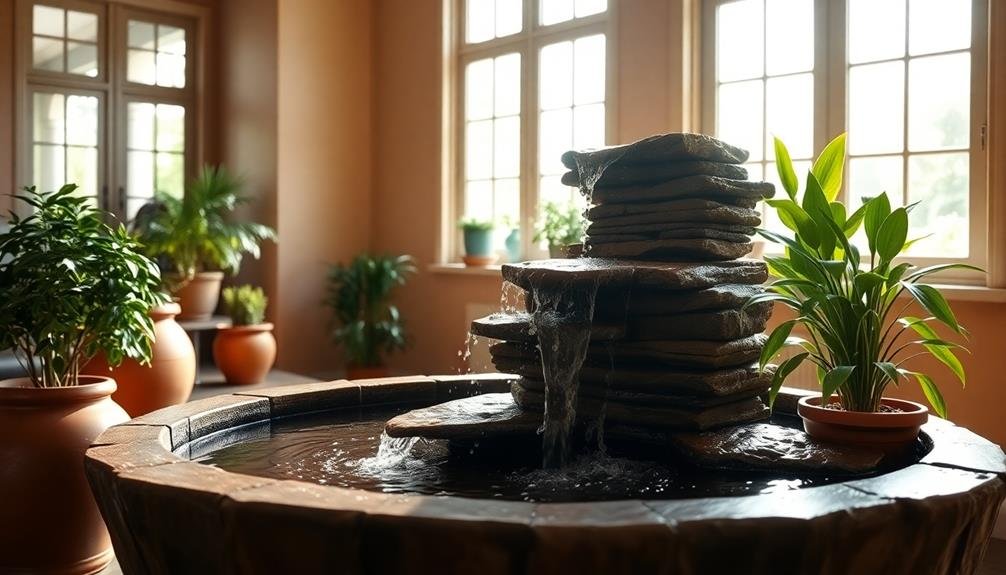
Water features can notably enhance your home's thermal mass properties.
You can incorporate indoor ponds, fountains, aquariums, or decorative water walls to absorb and release heat slowly throughout the day.
These elements not only add aesthetic value but also help regulate indoor temperatures, making your living space more comfortable and energy-efficient.
Indoor Ponds and Fountains
Indoor ponds and fountains offer a unique way to incorporate thermal mass into your living space. These water features not only add aesthetic appeal but also contribute to temperature regulation. Water's high specific heat capacity allows it to absorb and release heat slowly, helping to stabilize indoor temperatures throughout the day.
When designing an indoor pond or fountain, consider the following:
- Size and location: Larger water features have a greater impact on thermal mass, but even small fountains can make a difference. Place them in areas that receive indirect sunlight for peak performance.
- Material choices: Surround your water feature with materials like stone or tile, which complement water's thermal properties.
- Maintenance requirements: Confirm you're prepared for regular cleaning and upkeep to prevent algae growth and maintain water quality.
You'll notice a more consistent indoor temperature as the water absorbs excess heat during the day and releases it at night. This natural cooling and heating effect can reduce your reliance on artificial climate control systems, potentially lowering energy costs.
Additionally, indoor water features can improve air quality by increasing humidity and filtering dust particles, creating a more comfortable living environment.
Aquarium Heat Absorption
In addition to ponds and fountains, aquariums can serve as effective thermal mass elements in your home. These water-filled displays not only add aesthetic appeal but also contribute to temperature regulation. Aquariums absorb heat during warmer periods and release it when the surrounding air cools, helping to stabilize your home's internal temperature.
To maximize an aquarium's thermal mass potential, consider its size and placement. Larger tanks hold more water, increasing their heat absorption capacity. Position your aquarium in areas that receive direct sunlight or near heat sources to enhance its effectiveness. However, be mindful of the fish's needs and avoid excessive temperature fluctuations.
You can further boost your aquarium's thermal mass properties by incorporating materials like rocks or driftwood. These dense objects absorb and retain heat, complementing the water's thermal properties. Additionally, the aquarium's filtration system aids in heat distribution as water circulates throughout the tank.
Remember that while aquariums can contribute to thermal mass, they shouldn't be your sole solution. Combine them with other strategies like proper insulation and strategic window placement for ideal temperature control in your home.
Decorative Water Walls
Another innovative way to incorporate thermal mass into your home's design is through decorative water walls.
These vertical water features not only add a stunning visual element to your space but also contribute to temperature regulation. Water has an excellent capacity for heat absorption and retention, making it an ideal material for thermal mass.
When you install a decorative water wall, you're creating a natural cooling system. As the water circulates and evaporates, it helps lower the ambient temperature, especially during hot summer days.
In winter, the water can absorb heat from sunlight or indoor heating systems, slowly releasing it back into the room as temperatures drop.
To maximize the benefits of a decorative water wall:
- Position it in an area that receives direct sunlight or near a heat source
- Choose a design with a large surface area for better heat exchange
- Integrate it with your home's ventilation system for improved air circulation
Flooring Choices for Thermal Mass
When it comes to flooring choices for thermal mass, you'll want to contemplate materials that can effectively absorb and store heat.
Concrete is an excellent option, offering high thermal mass capacity and versatility in design. You can polish, stain, or stamp concrete floors to achieve various aesthetic looks while maintaining their heat-retaining properties.
Natural stone, such as slate, granite, or marble, also provides significant thermal mass. These materials not only add elegance to your space but also help regulate indoor temperatures.
Ceramic or porcelain tiles are another viable choice, offering good thermal properties and a wide range of styles.
For a warmer feel underfoot, consider brick flooring. It absorbs heat during the day and releases it slowly at night, contributing to temperature stability.
Alternatively, you might opt for a compromise between thermal mass and comfort by using a thin layer of cork or wood over a concrete subfloor.
Walls and Thermal Mass Integration
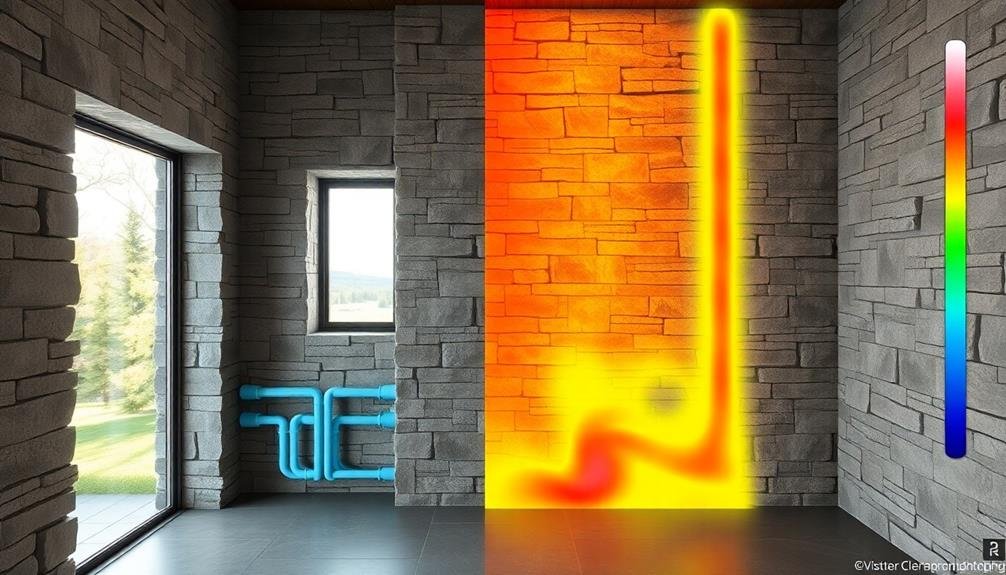
When integrating thermal mass into your walls, you'll need to contemplate both material selection and strategic placement.
For material choices, focus on dense options like concrete, stone, or brick that can effectively absorb and store heat.
You can incorporate these materials directly into load-bearing walls or add them as interior features, such as accent walls or partitions, to maximize thermal mass benefits throughout your living space.
Material Selection for Walls
Selecting the right materials for your walls is essential when integrating thermal mass into your building's design. You'll want to choose materials with high thermal mass properties, such as concrete, brick, or stone. These dense materials can absorb and store heat during the day, releasing it slowly at night to help maintain a stable indoor temperature.
When considering wall materials for thermal mass, keep these factors in mind:
- Density: Denser materials generally have better thermal mass properties.
- Specific heat capacity: This measures how much heat a material can store per unit of mass.
- Thermal conductivity: This determines how quickly heat moves through the material.
Concrete is an excellent choice for thermal mass walls due to its high density and specific heat capacity. It's also versatile and can be used in various forms, such as precast panels or poured-in-place walls.
Brick and stone are other popular options, offering both thermal benefits and aesthetic appeal. For a more eco-friendly approach, you might consider rammed earth or adobe, which provide good thermal mass properties while using natural, locally sourced materials.
Remember that the thickness of your walls will also impact their thermal performance, so consult with an architect or engineer to determine the ideal dimensions for your specific climate and building design.
Thermal Mass Placement Strategies
In accordance with effective thermal mass design, strategic placement of high-density materials within your walls is essential.
You'll want to focus on integrating thermal mass materials into interior walls and partitions, as they're more effective at regulating indoor temperatures than exterior walls. Consider using concrete, brick, or stone for these interior walls, particularly in areas that receive direct sunlight.
For ideal performance, place thermal mass walls perpendicular to windows facing south (in the Northern Hemisphere) or north (in the Southern Hemisphere). This allows the walls to absorb and store heat from the sun during the day and release it slowly at night.
You can also incorporate thermal mass into floor slabs, which can be particularly effective when combined with radiant heating systems.
Don't forget about vertical integration. Installing thermal mass materials at different heights within your walls can help distribute heat more evenly throughout the space.
Consider using a combination of low and high thermal mass placements to create a balanced temperature regulation system.
Ceiling and Roof Considerations
While walls and floors often get the most attention in thermal mass discussions, ceilings and roofs play a crucial role in a building's overall thermal performance.
They're your home's first line of defense against the sun's heat and can greatly impact indoor comfort. When considering thermal mass for your ceiling and roof, you'll want to focus on materials that can absorb and store heat effectively.
Concrete or clay tiles are excellent options for roofing, as they provide substantial thermal mass. Inside, exposed concrete ceilings or thick plaster can help regulate temperature.
If you're retrofitting an existing home, you might consider adding a layer of phase change materials to your ceiling to enhance its thermal storage capacity.
Here are three key considerations for ceiling and roof thermal mass:
- Insulation placement: Verify proper insulation above the thermal mass to prevent unwanted heat gain or loss
- Ventilation: Incorporate adequate roof ventilation to manage moisture and heat buildup
- Color choice: Opt for lighter colors on exterior surfaces to reflect sunlight and reduce heat absorption
Outdoor Thermal Mass Applications
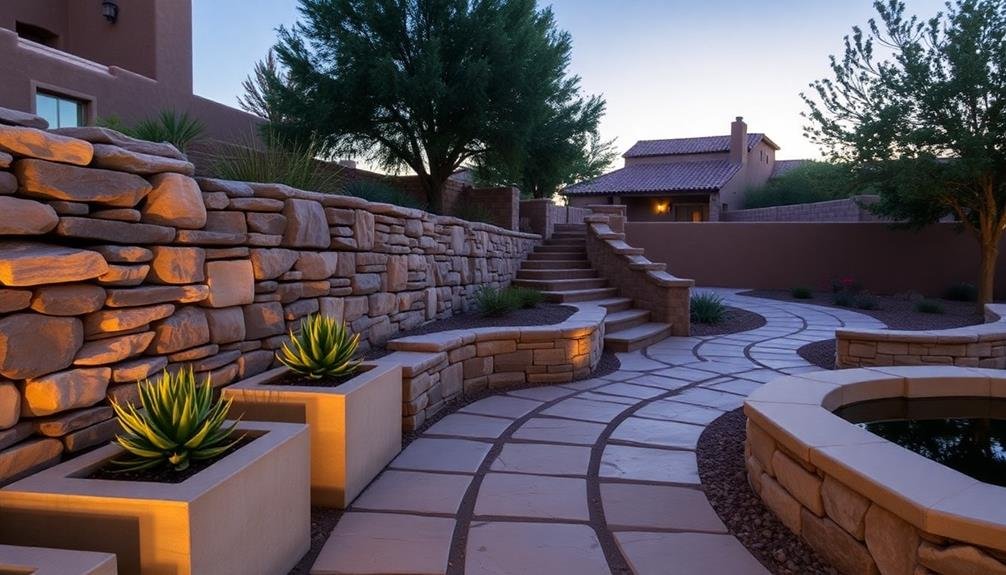
Beyond the confines of your home, thermal mass can be a powerful tool for outdoor climate control. You can strategically incorporate thermal mass elements in your landscaping to create more comfortable outdoor spaces.
Consider using materials like stone, concrete, or brick for patios, walkways, and retaining walls. These dense materials absorb heat during the day and release it slowly at night, helping to moderate temperature fluctuations.
Water features, such as ponds or fountains, also act as excellent thermal mass elements. They absorb heat during hot days and release it gradually, creating a cooling effect in the surrounding area. You can further enhance this effect by positioning seating areas near these water features.
Don't overlook the potential of outdoor structures like pergolas or gazebos. By incorporating thermal mass materials into their design, you'll create shaded areas that remain cooler during the day and warmer in the evening.
You can also use large planters or raised beds filled with soil as thermal mass elements. Not only will they help regulate temperature, but they'll also provide opportunities for gardening and landscaping.
Seasonal Considerations for Thermal Mass
The effectiveness of thermal mass fluctuates throughout the year, depending on seasonal changes. You'll need to adjust your thermal mass strategy to maximize its benefits in different seasons.
In summer, focus on using thermal mass to absorb excess heat during the day and release it at night when temperatures drop. This helps keep your home cooler during peak hours.
In winter, aim to capture and store solar heat during the day to release it slowly at night, reducing your heating needs.
To optimize your thermal mass for seasonal changes:
- Use window treatments strategically: In summer, close blinds or curtains during the day to prevent direct sunlight from heating thermal mass surfaces. In winter, open them to allow sunlight to warm these surfaces.
- Adjust ventilation: Increase nighttime ventilation in summer to help thermal mass release stored heat. In winter, minimize ventilation to retain the warmth stored in thermal mass.
- Consider movable thermal mass: Use items like water-filled containers that you can relocate seasonally to areas where they're most effective.
Combining With Other Energy Solutions
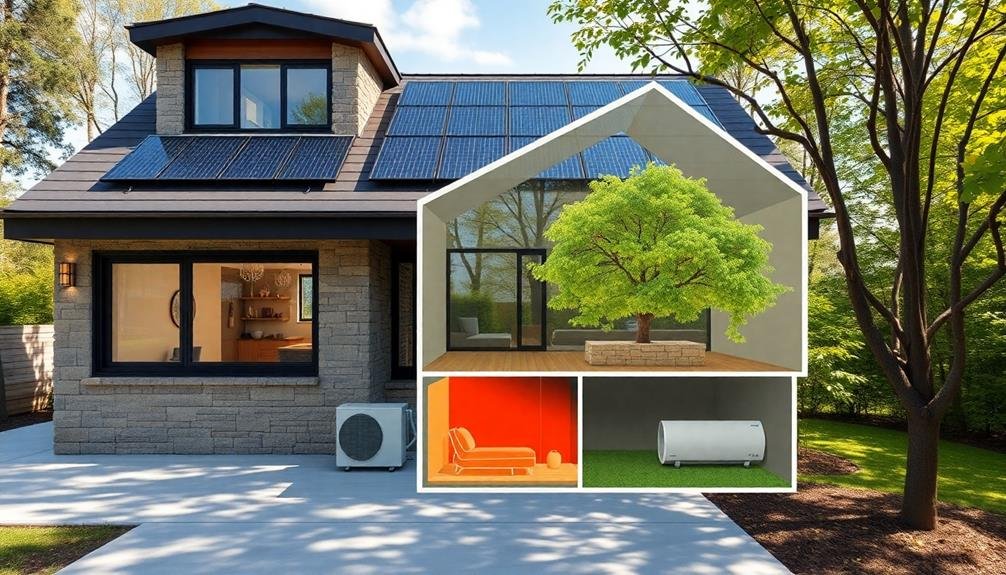
Thermal mass is a powerful tool for energy efficiency, but it's not a standalone solution. To maximize its benefits, you'll want to combine thermal mass with other energy-saving strategies. By integrating multiple approaches, you can create a thorough system that optimizes your home's energy performance.
Consider pairing thermal mass with these complementary solutions:
| Energy Solution | Benefits | Synergy with Thermal Mass |
|---|---|---|
| Solar Panels | Generate electricity | Power cooling systems |
| Insulation | Reduce heat transfer | Enhance temperature stability |
| Smart Thermostats | Automate temperature control | Optimize thermal mass cycles |
| Passive Solar Design | Harness natural heat | Amplify thermal mass effects |
| Geothermal Systems | Efficient heating/cooling | Supplement thermal mass regulation |
When you combine thermal mass with these technologies, you'll create a more robust and efficient energy system. For example, solar panels can power cooling systems during peak summer hours, while thermal mass helps maintain comfortable temperatures throughout the day. Smart thermostats can be programmed to work in tandem with your thermal mass, anticipating temperature changes and adjusting accordingly. By leveraging these synergies, you'll greatly reduce your energy consumption and create a more sustainable home environment.
Frequently Asked Questions
How Long Does It Take to See the Effects of Thermal Mass?
You'll notice thermal mass effects within hours, but full benefits take days. It depends on your climate and materials used. You'll see temperature stabilization and energy savings gradually improve over time as the system balances out.
Can Thermal Mass Increase the Value of My Home?
Yes, thermal mass can increase your home's value. It'll enhance energy efficiency, reduce utility costs, and improve comfort. Buyers often appreciate these features, potentially making your property more attractive and valuable in the real estate market.
Are There Any Potential Drawbacks to Using Thermal Mass in Homes?
You might face some drawbacks with thermal mass in homes. It can lead to overheating in summer, increase construction costs, and limit design flexibility. You'll also need careful planning to optimize its benefits and avoid moisture issues.
How Does Thermal Mass Affect Indoor Air Quality and Humidity Levels?
Thermal mass can impact your indoor air quality and humidity. It'll absorb excess moisture, reducing humidity when it's high. However, it may also trap pollutants and release them slowly, so proper ventilation is essential for maintaining good air quality.
Can Thermal Mass Be Effectively Used in All Climate Zones?
Thermal mass can be effective in most climate zones, but it's not equally beneficial everywhere. You'll get the best results in areas with significant temperature swings. In extremely hot or cold climates, you'll need additional strategies for ideal comfort.
In Summary
You've now learned how to harness thermal mass to naturally stabilize your home's temperature. By strategically incorporating materials like concrete, stone, and water, you'll reduce energy costs and create a more comfortable living space. Remember to take into account seasonal variations and combine thermal mass with other energy-efficient solutions. Whether you're building new or renovating, implementing these principles will help you create a more sustainable and comfortable home for years to come.





Leave a Reply